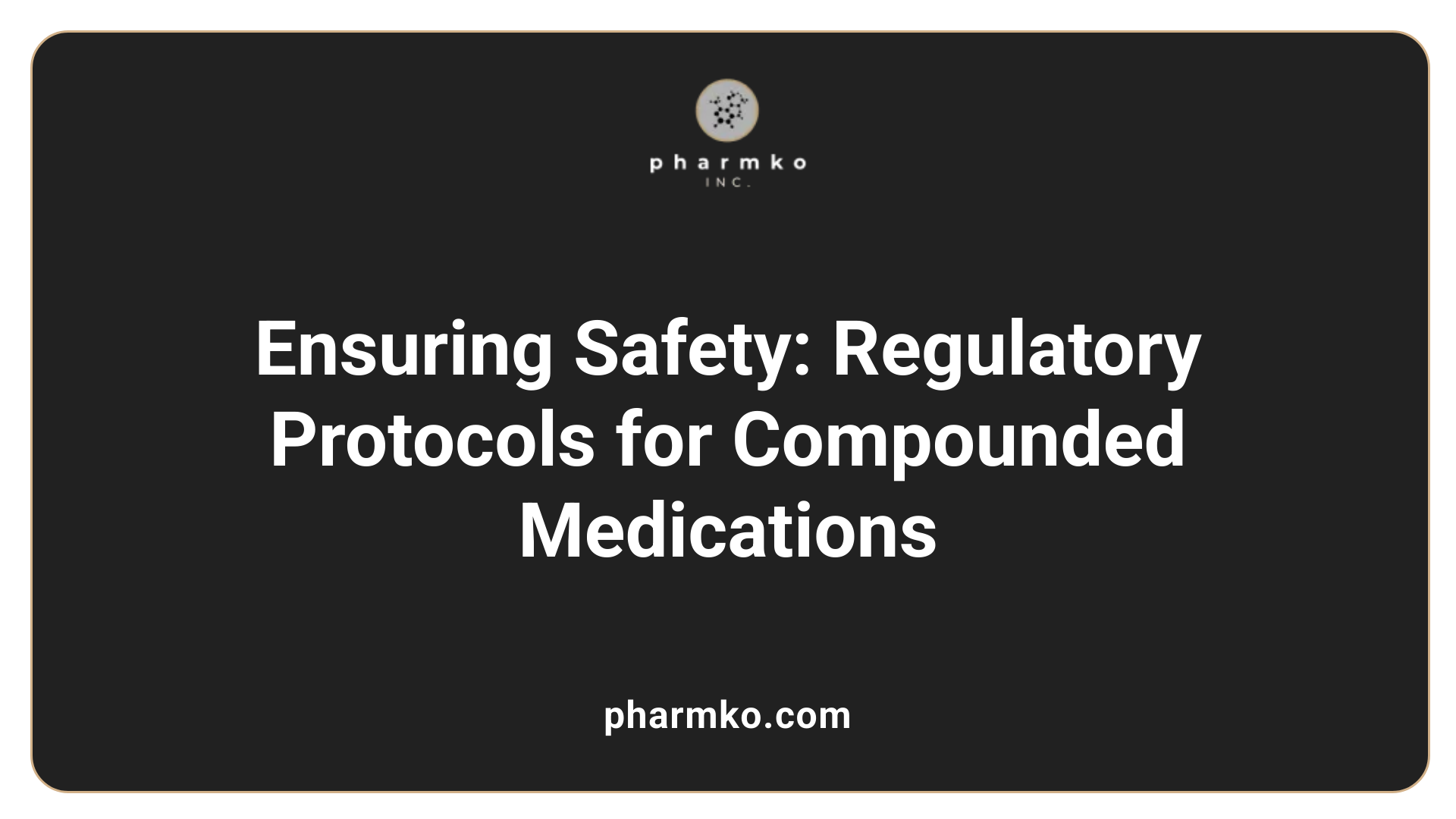Compounded medications for infusion care

Understanding Compounded Medications in Infusion Care
Compounded medications are a cornerstone of personalized medical treatments, allowing healthcare providers to address unique patient needs with precision. Particularly important in infusion care, these customized drugs support patients requiring specialized pharmaceutical interventions. Through a collaborative effort involving pharmacists, healthcare providers, and patients, compounded medications aim to deliver optimal therapeutic outcomes. This article explores various facets of compounded medications in infusion care, from safety practices and regulatory standards to their role in home and inpatient settings.
How Does Home Infusion Therapy Work and What Are Its Benefits?

How does home infusion therapy work?
Home infusion therapy is administered through a needle or catheter directly in a patient's home, replacing the need for prolonged hospital stays. This treatment is guided by a dedicated team of healthcare professionals, including nurses and pharmacists, who tailor the infusion process to meet the unique needs of each patient. They ensure that medications—like intravenous (IV) antibiotics, chemotherapy, or hydration—are safely and effectively administered.
Patients may receive care from various organizations, including specialized infusion companies and community pharmacies, that adhere to strict protocols to maintain drug sterility and proper administration techniques. Home infusion practices also include thorough patient assessments and ongoing education to ensure that both patients and caregivers understand medication administration and equipment handling.
What are the benefits of home-based infusion care?
The advantages of home infusion therapy extend beyond convenience:
- Quality of Life Improvement: Patients can continue their daily routines while receiving necessary medications, significantly enhancing their quality of life.
- Cost-Effective: Home-based care often reduces overall healthcare costs by decreasing hospital visits and stays.
- Lower Infection Risks: Receiving treatment in the home environment decreases exposure to hospital-associated infections, particularly important for patients with compromised immune systems.
- Accessibility: With services covered by Medicare and various insurance plans, patients have better access to essential treatments.
With approximately 3.2 million patients receiving home infusion annually, this model of care not only addresses serious health conditions effectively but also alleviates the stress often associated with hospital environments. Understanding these elements helps highlight the importance and efficacy of home infusion therapy in modern healthcare.
The Necessity of Compounded Drugs in Patient Care

Why do some patients need compounded drugs?
Some patients often rely on compounded drugs to meet their unique health requirements. This is particularly true for individuals with specific allergies, such as reactions to preservatives or fillers in commercially available medications. Compounding allows pharmacists to customize formulations, adjusting dosages or altering the medication's form, creating options like liquids or lollipops—making it easier for patients who struggle with swallowing pills.
Additionally, compounded medications are crucial when patients require specific drug combinations or dosages that are unavailable on the market. Conditions like complex chronic illnesses may necessitate personalized therapy that standard pharmaceuticals cannot offer. However, it is essential to understand that these compounded drugs lack the rigorous FDA scrutiny that traditional medications undergo, leading to concerns about their safety and efficacy. Thus, patients must procure these medications from accredited and reputable facilities to reduce associated risks.
Challenges associated with compounded medications
The challenges surrounding compounded drugs are significant. One primary concern is the risk of contamination, as compounded products can be prepared under unsafe conditions. Reports of adverse events, including serious infections due to contaminated preparations, underscore this danger.
Moreover, certain compounding practices linked to business models like IV hydration clinics may not always comply with regulatory standards, raising doubts about quality. Ensuring that these drugs are prepared in accordance with established guidelines, such as USP <797>, is critical to maintaining patient safety.
Overall, while compounded medications play a vital role in personalized patient care, they require careful oversight and adherence to quality standards to mitigate potential risks.
Popular IV Infusion Drugs and Their Applications

What drugs are most commonly given by IV infusion?
Drugs administered via intravenous (IV) infusion play a pivotal role in modern medicine, particularly for patients with conditions that require immediate therapeutic action. Common medications include:
Chemotherapy Agents:
- Doxorubicin
- Vincristine
- Cisplatin
- Paclitaxel
These drugs are critical in cancer treatment, targeting rapidly dividing cells to inhibit tumor growth.
Antibiotics:
- Vancomycin
- Meropenem
- Gentamicin
Intravenous antibiotics are often necessary for serious infections where oral alternatives fail, ensuring quick and effective pathogen eradication.
Antifungals:
- Micafungin
- Amphotericin
Used for invasive fungal infections, these agents are vital for immunocompromised patients.
Pain Management Medications:
- Hydromorphone
- Morphine
These opioids provide rapid relief for acute pain, especially in postoperative or cancer patients, enhancing comfort and quality of life.
Application and importance of IV medications
IV administration is paramount for multiple reasons. It facilitates rapid drug delivery, making it indispensable in emergencies where oral medications are ineffective or unsafe. Short-term treatments frequently utilize peripheral IV lines, while central venous catheters are ideal for prolonged therapies, such as those required in chronic illnesses.
Moreover, IV fluids are crucial for treating hydration issues in cases of moderate to severe dehydration, ensuring patients maintain optimal body function. Close patient monitoring during IV administration helps mitigate potential complications such as infections, air embolisms, or electrolyte imbalances, underscoring the importance of skilled healthcare professionals in this process.
The ongoing demand for IV infusion therapies reflects their critical role in managing severe health conditions, highlighting their importance in improving patient outcomes.
Variety of Diseases Managed by Infusion Therapy

What diseases are treated with infusion therapy?
Infusion therapy addresses a wide range of diseases, particularly those that are chronic or complex, as well as those not effectively managed with oral medications. Here are some notable conditions treated with this approach:
- Crohn's Disease and Ulcerative Colitis: These inflammatory bowel diseases often require aggressive treatment that may not respond to standard oral therapies.
- Rheumatoid Arthritis and Lupus: Patients with autoimmune disorders benefit from infused biologic therapies designed to modulate immune response.
- Multiple Sclerosis: Infusion therapy can provide essential disease-modifying agents that are critical in managing this progressive neurological condition.
- Severe Infections: Some infections do not adequately respond to oral antibiotics, requiring intravenous administration to ensure effective treatment.
- Cancer Treatments: Chemotherapy is frequently administered via infusion, ensuring that medications are delivered directly into the bloodstream for maximum effectiveness.
- Iron Deficiency Anemia: Iron infusions are a quick way to restore levels in patients who cannot take or absorb iron pills effectively.
- Dehydration from Gastrointestinal Issues: Infusion therapy can also be crucial for patients dealing with severe nausea, vomiting, or diarrhea, providing necessary hydration.
Infusion therapy serves as a vital treatment option for these and many other serious health conditions, emphasizing its role in enhancing patient care and outcomes.
Rationale for using infusion over oral medication
The choice of infusion therapy often stems from several rationales:
- Bioavailability: Infused medications bypass the digestive system, allowing for better absorption and immediate effects.
- Control: Healthcare providers can closely monitor the administration process, enhancing patient safety and response evaluation.
- Complex Cases: For patients with multiple health issues or those on various medications, infusion therapy can help manage their complex health needs more effectively.
- Severe Conditions: In cases of life-threatening conditions or where oral medications may not suffice, infusion therapy is often the preferred choice.
This targeted treatment modality plays a significant role in managing not just acute, but chronic health issues, ultimately enhancing the quality of life for patients.
Regulatory Landscape and Safety Protocols for Compounded Medications

What are the regulatory standards and protocols associated with compounded medications in infusion therapy?
Compounded medications in infusion therapy are governed by a complex set of regulatory standards to ensure their safety and efficacy. While these drugs are not FDA-approved, they must adhere to the guidelines established by the FDA and the United States Pharmacopeia (USP).
Particularly relevant are the standards outlined in USP chapter 797, which provides extensive regulations on sterile compounding practices. Compounding typically occurs in state-licensed pharmacies or outsourcing facilities, with the latter often facing more stringent oversight from the FDA.
Federal laws under sections 503A and 503B of the Drug Quality and Security Act delineate specific compounding requirements, including limits on bulk substances and the prohibition against compounding drugs that have been withdrawn from the market for safety reasons.
Essential quality assurance measures, such as environmental monitoring and ensuring staff competency in aseptic techniques, are critical to mitigating contamination risks and safeguarding patient safety.
How do compounded medications in infusion therapy compare with traditional pharmaceuticals offered in inpatient care?
Compounded medications provide tailored treatment options for patients with specific needs that traditional pharmaceuticals cannot meet. For instance, patients may have allergies, require unique dosage forms, or face challenges with standard medications.
Unlike FDA-approved drugs, compounded medications do not undergo the same level of rigorous evaluation for safety and efficacy, which raises potential quality concerns. However, compounding pharmacies can address medication shortages and create customized solutions, leading to improved patient adherence through personalized dosage forms and administration routes.
That said, the use of poorly compounded medications has been associated with serious adverse outcomes. While compounded medications play a crucial role in managing patient-specific needs, it is essential to consider their risks in comparison to the more established and regulated traditional pharmaceuticals.
Conclusion
Compounded medications are a vital component of infusion therapy, providing personalized care that addresses specific patient needs. With the growing trend towards home infusion therapy, patients enjoy improved quality of life and reduced healthcare costs. However, meticulous adherence to regulatory standards ensures the safety and efficacy of these preparations, underlining the necessity and complexity of compounded medications in modern healthcare.
References
- FDA highlights concerns with compounding of drug products by ...
- Home infusion therapy | Home care providers | NHIA
- [PDF] ASHP Guidelines on Home Infusion Pharmacy Services
- FDA Revises Hospital and Health System Compounding Guidance ...
- A Primer on Home Infusion Administration Methods - PMC
- NHIA Releases List of Home Infusion Medications
- Home Infusion | Sterile Compounding in Holly Hill, FL
- AIS Healthcare - Advancing quality. Improving lives.


































































































